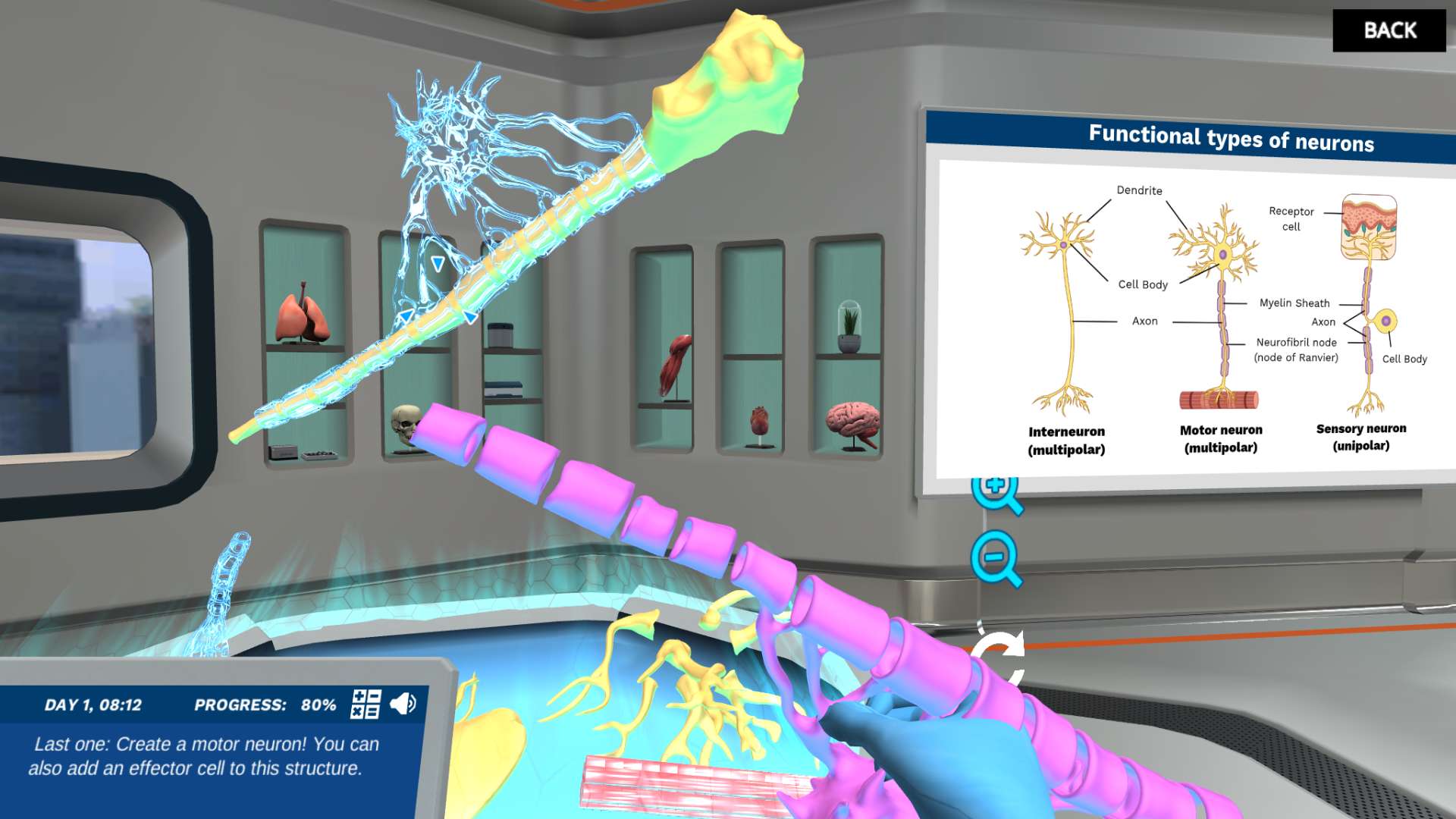Heading 1
Heading 2
Heading 3
Heading 4
Heading 5
Heading 6
Lorem ipsum dolor sit amet, consectetur adipiscing elit, sed do eiusmod tempor incididunt ut labore et dolore magna aliqua. Ut enim ad minim veniam, quis nostrud exercitation ullamco laboris nisi ut aliquip ex ea commodo consequat. Duis aute irure dolor in reprehenderit in voluptate velit esse cillum dolore eu fugiat nulla pariatur.
Block quote
Ordered list
- Item 1
- Item 2
- Item 3
Unordered list
- Item A
- Item B
- Item C
Bold text
Emphasis
Superscript
Subscript
About This Simulation
Step into Labster's anatomy and physiology lab to learn about the fundamental units of your nervous system; the neurons! Learn about the structure, classification, and special functions of neurons, as well as their mode of communication through synapses.
Learning Objectives
- Compare the microanatomy and roles of the three functional types of neuron
- Summarize roles of chemical and electrical synapses in neurotransmission
About This Simulation
Lab Techniques
Related Standards
Learn More About This Simulation
This short, targeted simulation is adapted from the full-length Gross Anatomy of the Nervous System simulation. Fire up your synapses to learn about neurons! In this simulation, you will learn about the building blocks of the nervous system and how these amazing cells communicate with each other through chemical or electrical synapses. Explore the microanatomy of neurons To start, you will learn the basic structure of a neuron, including the axon, axon terminal, cell body, dendrites, and glial cells that provide support to neurons. Understand how the signal is passed through the neuron and what happens when it reaches its destination. Learn about electrical and chemical synapses Watch an animation that illustrates the functioning of electrical and chemical synapses. You will follow the path of the electric impulse and how it is propagated. You’ll see how the action potential influences the generation of the signal and which cells are more likely to have electric or chemical synapses. You will also learn about the importance of neurotransmitters and their mode of action. Construct different types of neurons In the end you will be able to identify different types of neurons based on the bodily function they support and understand their complexity and importance. You will have the possibility to assemble motor, sensory, and interneurons to discover differences in their structure! Will you be able to reflect on how your own body works to answer the final questions?
For Science Programs Providing a Learning Advantage
Boost STEM Pass Rates
Boost Learning with Fun
75% of students show high engagement and improved grades with Labster
Discover Simulations That Match Your Syllabus
Easily bolster your learning objectives with relevant, interactive content
Place Students in the Shoes of Real Scientists
Practice a lab procedure or visualize theory through narrative-driven scenarios


FAQs
Find answers to frequently asked questions.
Heading 1
Heading 2
Heading 3
Heading 4
Heading 5
Heading 6
Lorem ipsum dolor sit amet, consectetur adipiscing elit, sed do eiusmod tempor incididunt ut labore et dolore magna aliqua. Ut enim ad minim veniam, quis nostrud exercitation ullamco laboris nisi ut aliquip ex ea commodo consequat. Duis aute irure dolor in reprehenderit in voluptate velit esse cillum dolore eu fugiat nulla pariatur.
Block quote
Ordered list
- Item 1
- Item 2
- Item 3
Unordered list
- Item A
- Item B
- Item C
Bold text
Emphasis
Superscript
Subscript
A Labster virtual lab is an interactive, multimedia assignment that students access right from their computers. Many Labster virtual labs prepare students for success in college by introducing foundational knowledge using multimedia visualizations that make it easier to understand complex concepts. Other Labster virtual labs prepare learners for careers in STEM labs by giving them realistic practice on lab techniques and procedures.
Labster’s virtual lab simulations are created by scientists and designed to maximize engagement and interactivity. Unlike watching a video or reading a textbook, Labster virtual labs are interactive. To make progress, students must think critically and solve a real-world problem. We believe that learning by doing makes STEM stick.
Yes, Labster is compatible with all major LMS (Learning Management Systems) including Blackboard, Canvas, D2L, Moodle, and many others. Students can access Labster like any other assignment. If your institution does not choose an LMS integration, students will log into Labster’s Course Manager once they have an account created. Your institution will decide which is the best access method.
Labster is available for purchase by instructors, faculty, and administrators at education institutions. Purchasing our starter package, Labster Explorer, can be done using a credit card if you are located in the USA, Canada, or Mexico. If you are outside of North America or are choosing a higher plan, please speak with a Labster sales representative. Compare plans.
Labster supports a wide range of STEM courses at the high school, college, and university level across fields in biology, chemistry, physics, and health sciences. You can identify topics for your courses by searching our Content Catalog.















